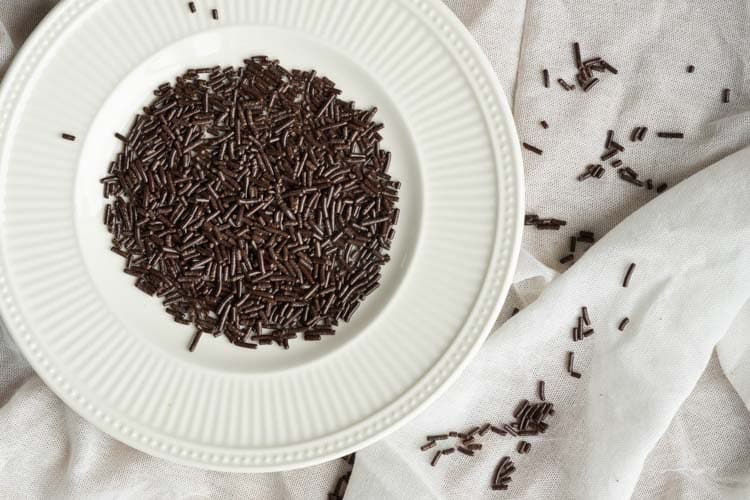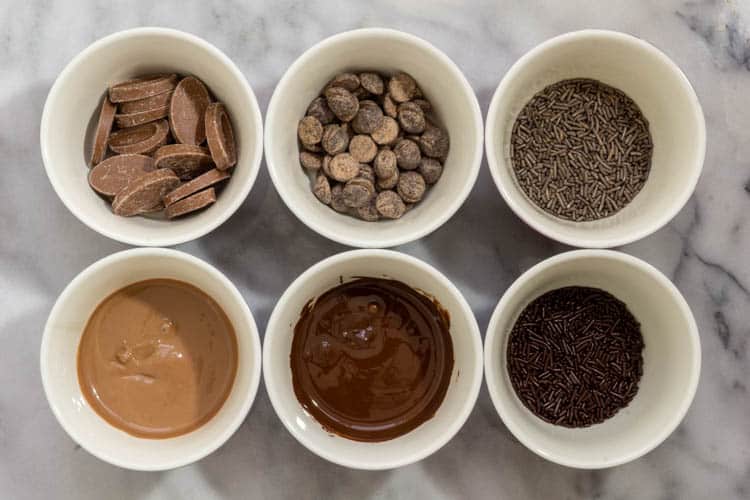Learn the science behind:

How Dutch Chocolate Sprinkles Are Made (& Eaten)
Is there a food you can’t go without? The one that you take with you on every vacation? If you’re Dutch, born and raised in the Netherlands, that one food might well be chocolate sprinkles. We Dutch don’t just use sprinkles to decorate cakes or muffins. No, chocolate sprinkles (and several other types of sprinkles) are a legitimate breakfast or lunch food, sprinkled on top of a slice of buttered bread. Don’t be surprised if they enter your breakfast or lunch table, even at a (fancy) hotel, when visiting the Netherlands. Whereas chocolate sprinkles definitely aren’t unique to the Netherlands, just how we use them is.
And chocolate sprinkles aren’t new, they’ve been around for about a hundred years, so about time to dig into the science of this somewhat typical Dutch food!
History of Dutch Chocolate Sprinkles
The exact origins of chocolate sprinkles in the Netherlands aren’t clear, as is so often the case for foods. Upon looking for references for chocolate sprinkles in old cookbooks, you’ll be able to find them being referred to in books from the 1920s and 1930s. At the time they weren’t (yet) referred to to be eaten on a slice of bread. Instead, most of these older references use chocolate sprinkles to decorate pies and cakes.
A first proper reference to the manufacturing of these sprinkles shows up in the early 1930s. At the time, a man, who owned a candy factory, started making sprinkles. These very first sprinkles likely weren’t chocolate, but aniseed based (scroll down to the end to see the original recipe!). It didn’t take long though for a chocolate variety to enter the market. These sprinkles proved to be quite a success!
The ‘inventor’ of chocolate sprinkles in the Netherlands was a man named Venco. Nowadays this brand isn’t known anymore for sprinkles, instead, it’s a well-known (in the Netherlands that is) licorice brand!
From the late 1930s, another major company started producing chocolate sprinkles. This company, Venz, still exists and still makes chocolate sprinkles. Nowadays, they’re accompanied by a range of companies all making their own variety of chocolate sprinkles.
Aside from the regular chocolate sprinkles, you can find white sprinkles, milk, dark chocolate, those with extra cocoa, extra thick, extra long, extra small, a mix of several types, with an addition of other little chocolate figurines. Sprinkles take up a good chunk of isle space in any Dutch supermarket! Just about any variation has been made or is being made, and nowadays most of these will end up on someone’s sandwich.
Making chocolate sprinkles
Sprinkles are little round tubes, about a millimeter in diameter (depending on the type) and generally less than a centimeter in length.
The Ingredients
In order for something to be called ‘chocolate’ sprinkles there are strict guidelines as to what this product can and cannot contain. The term ‘chocolate’ is protected quite extensively. Sprinkles made without cocoa, the key ingredient for chocolate, can’t be called chocolate. If you’d look at a pack of chocolate sprinkles you’ll probably see cocoa powder and cocoa butter in the ingredient list. These both come from cocoa.
Aside from cocoa, you will probably find sugar and soy lecithin in the ingredient list. Sugar provides sweetness (pure cocoa powder is very bitter!) and lecithin helps all the ingredients to come together, it’s an emulsifier. In milk chocolate varieties you will also find some dry milk ingredients (e.g. milk powder or milk fat).
Mixing and extruding
Making cocoa butter and cocoa powder is quite an extensive process. The cocoa bean needs to be harvested, fermented, dried, roasted, and ground before you end up with these ingredients. However, once you have these two ingredients the making of sprinkles is relatively simple, it’s mostly just mixing!
In large mixers all the ingredients are added and mixed together. This gives a sturdy chocolate dough, a lot like an unbaked cookie dough with regards to its stiffness and consistency.
Next up, the dough needs to be transformed into all these little chocolate sprinkles! Manufacturers use an extruder for this process. The extruder pushes the dough through a lot of little holes (a die plate) creating a lot of thin chocolate sprinkle strands. These strands are then broken or cut in the desired length and the sprinkles are born.
Lastly, to give the sprinkles some shine they can be tumbled in a large pan where they’re sprayed with a thin layer of wax. The wax helps the sprinkles to remain shiny over time.
Did you know? In Dutch sprinkles are called ‘hagelslag’, literally meaning hail battle or hail beating.
Sprinkles don’t melt
Making chocolate sprinkles is a very fast process. This as opposed to ‘regular’ chocolate, the type of chocolate that you can find in a tablet or bar. That type of chocolate also starts out with a mixing process called conching. However, instead of taking minutes or half an hour max. this process can take hours. At the end of the process, you have beautifully smooth liquid chocolate that flows really well. This is important because the chocolate needs to be dosed into molds or poured over a filling.
Since sprinkles are extruded and not poured, the chocolate does not need to be liquid, and sprinkles manufacturers use this to their advantage. By skipping the ‘conching’ step and just mixing the ingredients for a short period of time the process is a lot more efficient!
This shortcut does mean that the chocolate in sprinkles can’t be used the same way ‘regular’ chocolate can. Chocolate sprinkles don’t melt into a puddle when they’re heated. Instead, they keep their shape (see photo below). This is not a problem if you’d like to use them within a cookie dough or a cake, but it does mean you can’t use them for making a ganache or any other application that requires you to melt your chocolate!

Bakery made chocolate sprinkles
A quick note on chocolate sprinkles that you can buy in a bakery. As opposed to factory-made sprinkles, sprinkles made in a more artisanal bakery do tend to be made of ‘regular’, thus conched, chocolate. Making sprinkles is a good way to use up leftover chocolate and limiting the amount you might have to throw away. Since chocolate is an expensive ingredient in bakeries they try to use it all!
The other types of Dutch sprinkles
Even though the majority of Dutch sprinkles is the chocolate variety there are quite a few others that we’d like to quickly point out.
Vlokken
First of all, one that is very similar to the sprinkles: vlokken (translates as ‘flakes’). These flakes are made out of chocolate but instead of being round, they’re flat. They are made in a very similar way but instead of being extruded, they’re scraped off a large cooled wheel. Vlokken aren’t as glossy as sprinkles since they can’t be tumbled in a pan to be coated in wax. The tumbling would break all the flakes!
Fruit & Aniseed sprinkles
The other big category worthwhile pointing out are varieties that are actually very similar to the ‘original’ sprinkles of which we shared the recipe earlier in this article. These sprinkles are sugar based (with some starch) and tend to have either a fruity flavor (and color) or aniseed flavor. The production process for these won’t be that different from the recipe mentioned above!

A Dutch baby birth tradition
If you’re visiting new parents who’ve just had a baby in the Netherlands chances are you’ll be served a very specific snack: “beschuit met muisjes”. This is essentially a piece of rusk with a little butter (or margarine) with yet another type of sprinkles on top. These ‘sprinkles’ are actually sugar coated aniseeds! Traditionally aniseeds were seen are beneficial for the new mother and so served after birth. This tradition morphed into yet another type of sprinkle to put on top of a sandwich.

Muisjes are ‘little mice’ since the sugar-coated aniseeds look a little like tiny mice, they can even have a little tail!
The tradition of ‘beschuit met muisjes’ started with the birth of the previous Dutch queen. Beatrix. The manufacturer of ‘muisjes’ gifted a pack of them to the royal family upon her birth. Ever since it has been a tradition to eat them.
So next time you see a Dutchman (or woman) at a campground with a pack of sprinkles, you’ll understand sprinkles they aren’t crazy, they’re just Dutch :-)!

Hagelslag (sprinkles)
This recipe for sprinkles isn't one to make at home, instead, it's a copy of the original (handwritten) recipe used in the Venco factory to make sprinkles! You will notice that these aren't chocolate sprinkles, instead, this one is sugar based.
You can find the original in the Archives of the city of Amsterdam. Below I've translated the Dutch original in English, staying as close to the original as possible.
Ingredients
- 50 kg sugar
- 3 ounces (= 300g) glue*
- 3 liter water
- anisol (30g per 10kg)
Instructions
- When the dough is ready*** it will be processed further while wet in a granulation machine, during which a coarse grain should be made.
- Then bake in stove, leave in for about 12 hours.
- Sieve through a coarse and fine sieve then perfume with anise-oil and leave to cool before packing.
Notes
*The recipe says glue yes. I'm not sure what that would have been made of, but it was probably obvious what is meant to the manufacturing crew at the time.
**Anisol (chemical name: Fenol methyl ether) has an aniseed/fennel type flavor and you would be able to find it in anise flavored liquors such as ouzo.
***They're clearly assuming you know what you're doing already when reading these instructions, no further guidance as to when the dough is 'ready' is given.
References
Het Klokhuis, Hagelslag en muisjes, 2-Mar-2012, link ; Dutch kids’ tv show
Lotgering-Hillebrand, R., Practische recepten voor de huisvrouw, ca. 1933, link (From: Koninklijke Bibliotheek) ; shows recipe using chocolate sprinkles
Davelaar, R., Het maken van taarten, 1924, p.92, link (from: Koninklijke bibliotheek)
Venz, Historie, link
NPO Radio 2, Waarom zijn vlokken dof en glanst hagelslag?, 24-Feb-2019, link
Willem Wever, Hoe wordt hagelslag gemaakt in de fabriek?, link
What's your challenge?
Struggling with your food product or production process? Not sure where to start and what to do? Or are you struggling to find and maintain the right expertise and knowledge in your food business?
That's where I might be able to help. Fill out a quick form to request a 30 minute discovery call so we can discuss your challenges. By the end, you'll know if, and how I might be able to help.





